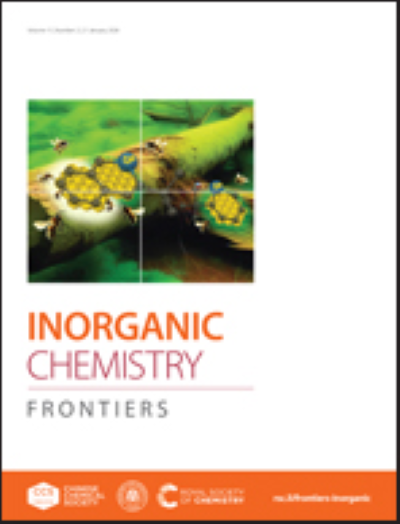纳米CuFeO2的高密度面结实现了选择性光催化CO2还原为CH4的高效电荷分离
IF 6.1
1区 化学
Q1 CHEMISTRY, INORGANIC & NUCLEAR
引用次数: 0
摘要
Facet结在促进光诱导电荷的分离方面已被证明是有效的。然而,光催化剂的微尺寸和有限的面结密度往往阻碍了光催化性能的提高。在这项工作中,我们提出了通过水热和酸蚀策略合成纳米级CuFeO2,从而形成具有高密度facet结的阶梯式CuFeO2六角形纳米片。实验表征和密度泛函理论(DFT)计算表明,台阶由水平(001)和垂直(- 120)两个面组成,这两个面之间的功函数差为0.74 eV,就会形成一个内置电场。表面光电压测量进一步证明了定向光诱导电子从(−120)转移到(001),从而在CuFeO2中产生富电子表面。结果表明,与非阶梯CuFeO2相比,具有高密度小面结的阶梯CuFeO2在将CO2还原为CH4方面表现出更好的光催化性能,还原速率为43.79 μmol g−1 h−1,选择性为78%。原位红外光谱进一步揭示了具有高密度facet结的阶梯式CuFeO2更有利于促进CH4生成的关键ch30 *中间体的形成。本文章由计算机程序翻译,如有差异,请以英文原文为准。

High density facet junctions in nano-stepped CuFeO2 enable efficient charge separation for selective photocatalytic CO2 reduction to CH4
Facet junctions have been demonstrated to be effective in promoting the separation of photoinduced charges. However, the micro-size of photocatalysts with a limited density of facet junctions usually hinders the improvement of photocatalytic performance. In this work, we propose the synthesis of nanoscale CuFeO2 through a hydrothermal and acid etching strategy, which leads to the formation of stepped CuFeO2 hexagonal nanosheets with high-density facet junctions. Experimental characterization and density functional theory (DFT) calculations indicate that the steps are composed of horizontal (001) and vertical (−120) facets that form facet junctions, between which a work function difference of 0.74 eV induces the formation of a built-in electric field. Surface photovoltage measurements further demonstrate directional photoinduced electron transfer from (−120) to (001) to generate an electron-rich surface in CuFeO2. As a result, the stepped CuFeO2 with high-density facet junctions exhibits superior photocatalytic performance in the reduction of CO2 to CH4 compared to non-stepped CuFeO2, with a rate of 43.79 μmol g−1 h−1 and 78% selectivity. In situ infrared spectroscopy further reveals that the stepped CuFeO2 with a high density of facet junctions is more conducive to the formation of key CH3O* intermediates that promote CH4 production.
求助全文
通过发布文献求助,成功后即可免费获取论文全文。
去求助
来源期刊

Inorganic Chemistry Frontiers
CHEMISTRY, INORGANIC & NUCLEAR-
CiteScore
10.40
自引率
7.10%
发文量
587
审稿时长
1.2 months
期刊介绍:
The international, high quality journal for interdisciplinary research between inorganic chemistry and related subjects
 求助内容:
求助内容: 应助结果提醒方式:
应助结果提醒方式:


